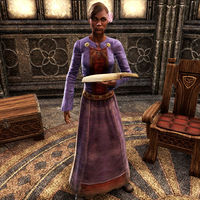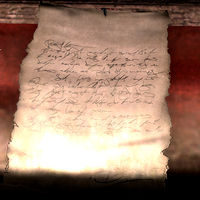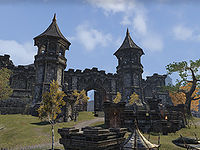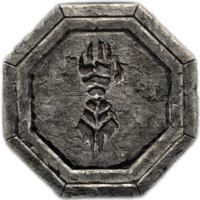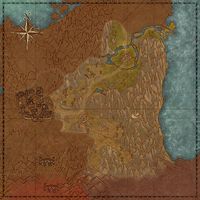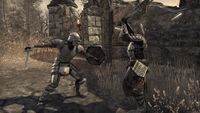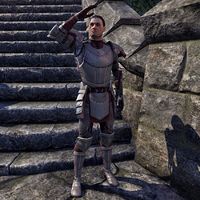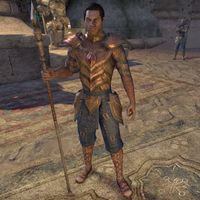Lore:Ranser's War
| Ranser's War | |||
|---|---|---|---|
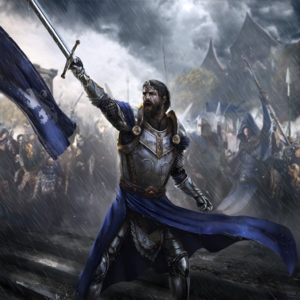 Emeric among covenant troops |
|||
| Date | 2E 566 – 2E 567 | ||
| Location | High Rock, The Systres | ||
| Result | Daggerfall Covenant and allies victory
|
||
| Participants | |||
| First Daggerfall Covenant | Kingdom of Rivenspire | ||
| Commanders and Leaders | |||
|
|
||
Ranser's War (also called King Ranser's War) was a civil conflict between the First Daggerfall Covenant and it's allies and the Kingdom of Rivenspire. The war began when King Ranser, furious with King Emeric for reneging on possible marriage arrangements with Ranser's daughter, launched a surprise attack on Wayrest. The ensuing war would last around a year with both sides suffering considerable casualties. In the end, the war would lead to large political ramifications and changes not only in Breton lands but abroad as well.
Contents
Background[edit]
The rise of Prince Ranser to the throne of Shornhelm was a conflict in it's own right. Although it was fought with words and ancient decrees instead of soldiers and weapons. When King Hurlburt passed away in 2E 546, there were two claimants to the throne, one of House Montclair and the other of House Branquette. The former was the fourteen year old Prince Phylgeon who was a legitimate son of the late King Hurlburt and Queen Iphilia while the latter was the eldest Prince Ranser, an illegitimate son born out of wedlock to a Tamrith cousin.
Phylgeon's claim was endorsed by House Montclair while Ranser's was endorsed by Houses Tamrith and Branquette. The Council of the North met to discuss and consider both claimants to the throne. After much deliberation the council narrowly voted to elevate Prince Ranser to the throne, though some cast doubt on the legitimacy of his claims brought before the council. Despite his critics, the now King Ranser would rule Shornhelm and the Kingdom of Rivenspire. Some number of Phylgeon's advisors wanted him to fight for the crown but the teenage prince instead chose peace, content to just be the Baron Montclair. This action is believed by some to have directly led to the outbreak of Ranser's war and the suffering of the Kingdom.[1]
Over a decade later to the south, King Gardner of Wayrest would be killed by the dreaded Knahatan Flu along with his entire royal line.[2] It would be in that year of 2E 563 that Earl Emeric of Cumberland would be elevated to the throne of Wayrest. He would rule as the first monarch of the new Cumberland Dynasty. King Emeric was unmarried when he took the throne and his advisors immediately set out to find him a suitable bride from the other kingdoms of High Rock to be his queen.[3] Early in the search, King Ranser would offer Emeric the hand of his daughter, Princess Rayelle. Ranser was adamant about this coupling and would bring it up often to his fellow king. He would also encourage his daughter to pen letters to Emeric that played up his good looks and virility.[4] Emeric was not against the idea and thought of the princess as a goodly woman. He would have made up his mind to take her as his queen had it not been for a fateful visit to the Kingdom of Sentinel.[3]
It was during this visit to King Fahara'jad's court that Emeric first laid eyes upon Princess Maraya, the eldest daughter of Fahara'jad. It was seeing her that made up Emeric's mind. Maraya would be his queen.[3] The sudden decision by Emeric to wed this Redguard maiden stunned many in his court and across the land. So much so that bards would sing of Maraya's surely bewitching beauty.[5] However, none were more stunned or more furious than King Ranser in the north.
Preparing for War[edit]
Despite the unexpected nature of Emeric's intent to marry Maraya, it was seen as a sound political move by strategists. The marriage had the chance to strengthen commerce between the kingdoms.[5] This turned out to be the case as Maraya's dowry consisted of a trade agreement between Wayrest and Sentinel that resulted in prosperity for both. All the kings of the Covenant would be invited to the wedding in the spring of 2E 566 including Ranser. He would not attend and would instead withdraw his ambassador from the court of Wayrest in his ever-growing anger.[3]
It was the preoccupation with his new bride and trade around the Illiac Bay that would keep Emeric from focusing on the seemingly distant mountain kingdom. With eye's turned away from him and unbeknownst to Emeric, Ranser had been building up his forces in the north.
Multiple allies were joining together behind King Ranser's banner. Large noble houses like House Tamrith, Dorell, and Montclair would join his side. Smaller noble families such as House Marcott would also support him.[6] House Ravenwatch would be the only nobility in the region to not take up arms and remained neutral. Ranser would further bolster his growing army with a host of mercenaries which he would draw from his kingdom's treasury to pay.[7][5][3]
Phylgeon Montclair would supposedly offer to serve as a peace envoy between the two monarchs, Ranser however would refuse and Emeric's reply is unknown. Failing to peacefully resolve the approaching conflict, Phylgeon would pledge the Montclair knights to Ranser.[1]
Another large noble house outside of Rivenspire would also throw in with Ranser's growing army. House Mornard of the Systres Archipelago was traditionally a vassal of Wayrest and the former Gardner Dynasty. However, due to Duke Avrippe Mornard's handling of the Knahaten Flu, the new Cumberland Dynasty looked with disfavor on House Mornard. Duke Mornard was shaken by Emeric's disappointment and began to look to other noble houses to be sure his house's position in the archipelago would be secure in the future. For this reason Avrippe would forsake his vassalage and pledge his house to King Ranser, sending knights and arms to his army.[8][9]
With allies gathered and his army bolstered, Ranser would attempt to enact revenge for what he saw as a betrayal.[10]
Wayrest Besieged[edit]
It was in Last Seed of 2E 566 that Ranser led his army out of Shornhelm in a fast attack to the south, with the vaunted Oldgate Lancer calvary at it's head, his troops tore through Alcaire and Menevia with lightning speed. Wayrest was almost completely unaware of their approach up to this point and had just begun mustering local militias when the Shornhelm advance guard arrived. These militias were still filing through the open city gate and were the only defense at the moment. If they were scattered and the gate taken, Wayrest could fall within the hour.
As luck would have it, King Emeric would arrive at the battle for the gate with both his house guard and the Lion Guard[5]. Seeing the situation at the gate grow increasingly desperate, Emeric ordered his bannerman to sound the charge. The king would lead his combined troops out onto the field against the lancers. These fresh troops wore full armor and Emeric, though unarmored, wielded his powerful enchanted broadsword known as the Orichalc Scalpel with great effect against the enemy. The attacking lancers were now up against veteran troops rather than just hastily gathered irregulars and were beginning to hesitate. As the battle went on the sudden arrival of a thunderstorm would be the deciding factor. The lancers, pelted by hail, their horses terrified by lightning, and losing ground against Wayrest's forces would break and run in disordered haste from the gate.
Their successful defense would give the troops time to get within the city walls and close the gates. Ranser had hoped for a swift victory but would now have to settle for putting Wayrest under siege. Though his spearhead had been blunted he was undeterred and the main body of his army would soon arrive equipped with siege engines.[3]
The ensuing siege would drag on for several months all the way into the spring of 2E 567. Wayrest would continue to hang on, depending on it's allied kingdoms to come to it's aid. The other kingdoms of the Covenant had been watching the war unfold and some even considered allowing Wayrest to fall despite being part of the defense pact. Allowing the richest city in the region to fall could not be allowed however and the kingdoms of Daggerfall, Camlorn, and Evermore would finally mobilize their forces and march to the defense of the besieged city.
Ranser's army was now having to fight not only the city but attacks from the countryside as well. His forces held their positions despite this as his troops were well paid and prepared for battle. It was not until a fleet of ships carrying battalions of elite Alik'r warriors crossed the Illiac Bay that Shornhelm's forces could no longer hold. They were routed and the siege of Wayrest was broken. The combined forces of Emeric's Bretons and Fahara'jad's Redguards would push Ranser's retreating forces back towards the north.[5][11]
Joining of Clan Bagrakh[edit]
King Ranser's forces were now at a disadvantage and were losing the ground they had gained at the onset of the war. They would be pushed back towards Shornhelm over the course of the next several months. To make the situation worse, House Tamrith would withdraw it's support for Ranser and call for peace. House Dorell did the same shortly after.[7] In contrast, King Emeric would cannily leverage his political ties to gain yet more allies to aid the war effort. He would employ privateers against Ranser's allies in the Systres. These ships would take part in naval battles and sink enemy ships off the coasts of the islands.[12] Furthermore, Emeric would dispatch his "chronicler" Zephrine Frey (in reality a trusted spy) to meet with the king's friend Kurog gro-Bagrakh, a young Orc chieftain in his mid-20s.[UOL 1]
At the time Chief Kurog and his clan were warring against the Nord clans of Falkreath in an attempt to reclaim the former chiefdom of Yashnag gro-Yazgu which had been lost in 2E 467.[13] Zephrine would catch up with Kurog in the mountains outside of Dragonstar where he had encamped his forces. She was a longtime friend of the chief and would listen as Kurog explained the difficulties of his campaign before presenting him with documents drawn up by Emeric that detailed an offer of mutual benefit if Kurog allied with him against Ranser. With Zephrine assuring him it was no Breton trickery, the two talked long into the night.
By the next morning Kurog would have a list of demands for Zephrine to return to the king. The demands were great but Emeric knew that the entry of these Orcs into the war could end the conflict much more quickly. He would agree to these demands and once the signed agreement was in Kurog's hands he would turn his forces toward their new enemy.[14]
Word of the new alliance that Emeric had forged with the Orcs would eventually reach King Ranser who would go mad with rage. His response would be to order his Spymaster Gerard Althen to arrest and interrogate all the Orcs living in Rivenspire. If they resisted or were found suspicious in any way, they were to be executed.[15] These orders would lead to the deaths of hundreds of innocent Orcs.[16]
Destruction of Shornhelm and The Battle of Markwasten Moor[edit]
With Kurog's Orcs now in position to the north of Ranser's retreating forces, the city of Shornhelm was open to attack whiles it's defenders were still to the south. The Orcish troops would descend upon the city in it's underdefended state. The Bretons of Shornhelm had made up the leadership of the assault that had sacked the previous incarnation of Orsinium in 2E 431[17] and the Orcs knew this history. They would see to it that the Bretons of Shornhelm paid their debt in full.
By the time Ranser and his forces had fallen back to their capital, it was already ablaze.[5] At the onset of the war Ranser had been so assured of his victory over Wayrest that he had preemptively distributed victory flags commemorating it[18] and had maps drawn up that displayed Rivenspire's theoretically extended borders.[19] Now, after nearly a year of conflict, it was his own capital that was burned and looted with the Orcs taking war spoils from the city.[20]
It was at this point that House Montclair would withdraw their support for King Ranser and surrender their troops to the Wayrest alliance.[7] With the city and much of the kingdom despoiled, Ranser would move his remaining forces east to the region of Markwasten Moor. Here, on the brink of defeat, they would prepare for a final stand.[11] On one side were the Breton and Redguard forces, on the other were the Orcs. Ranser's troops would find themselves encircled by the enemy and they were annihilated in the ensuing battle.[5] This would be a decisive victory for Emeric's forces with the bulk of Ranser's army being destroyed.[21]
The battle was so devastating that even years after the wars end some would believe that Ranser himself fell on the field that day.[21]This was not the case however as in reality the only ones to break out of the encirclement were Ranser himself and some of his most loyal troops including a few officers and aides.[11] This dwindling force would retreat to some ruins atop an unnamed tor outside the fallen city of Shornhelm.[22]
The Battle of Traitor's Tor[edit]
"Retreating—no, strike that! King Ranser doesn't retreat!"
"My strategic occupation of this tor shall be remembered as the most important military victory in Rivenspire's history. Let them throw all the Orcs they have at me. This tor will stand forever! I shall win this war!"-King Ranser's TiradeRanser's remnants would take up defensive positions atop the tor with Ranser proclaiming that there would be no more retreat[23] but the reality was that they were backed into a corner anyway. Kurog's Orcs would surround and begin to attack the ruins. Ranser's most loyal and trusted advisor General Dathieu Would attempt to defend the ruin's walls against the attackers, even using unconventional methods such as sleep scrolls against them to no avail. The Orcs would breach the crumbling walls of the ruins and the last of Ranser's wounded and battered troops would defend themselves with sword and arrow.[24] The army that had once besieged Wayrest was now reduced to no more than a few dozen troops which included the King's personal guard.[25]
Dathieu would see the hopelessness in continuing to fight and would see surrender as the only viable option that remained. The King however would dismiss the notion, seeming instead to prefer fighting to the end. The King's court magician Reezal-Jul had told him about a strategy involving magic that would still allow the battle and perhaps the war, to be won. Despite his doubts the general would send a lieutenant to carry out this plan but would maintain that if it didn't bring victory then he would try to convince Ranser to surrender. Adding that it seemed the King's mental state was deteriorating since the disastrous loss at Markwasten Moor. His hatred for Emeric clouding his better judgement.[25]
This lieutenant, who's name is lost to history, would carry out their orders and follow through with the steps needed for this ritual. They would then report to General Dathieu that this effort had been fruitless and nothing had happened.[24] The general would make up his mind that surrender was now the only option left and would send the same lieutenant to deliver these demands to the King. Ranser would hear none of it and would insist that the magical ritual was working as intended. Commanding the opposite of surrender, he would instead give orders for a counterattack. His personal guard under Captain Taern were to charge the Orcs ranks where they had breached the north wall. General Dathieu was ordered to lend his remaining soldiers to this last ditch attack. Ranser himself planned to join them on the battlefield.[26]
Upon receiving these orders, the general would be convinced of the King's madness and refuse to follow the order, not willing to waste more lives on a lost cause. He would plan to supersede the King's authority and restrain him so that they may surrender. He would wish for Captain Taern to join him but she had already received the orders and since she and her forces only took orders from the King himself would likely follow through with them. Dathieu would send his trusted lieutenant on one more mission to convince Taern to delay the charge while he went to confront Ranser personally. Intent on stopping him one way or the other.[25]
Ranser still would not listen to reason after being confronted and would instead declare Dathieu a coward.[26] Seeing no other way to save the lives of his men, the general would take matters into his own hands, quite literally stabbing King Ranser in the back. King Ranser's blood would be spilled on the ground by his own general. Unfortunately, the King's blood would serve as the necessary catalyst for the ritual. He would rise after death and curse Dathieu who in his attempt to save the lives of his men had damned them to a cursed undeath. The Orcs would wipe out the rest of the defenders who would later rise again, bound to Ranser.[11] The Crown of Shornhelm would be lost and only Reezal-Jul would survive the final battle, having managed to slink away after telling the king of the ritual.[25] Traitor's Tor as it would come to be called was left to rot as a cursed place.
With Ranser fallen and his forces either surrendered or destroyed, the war had come to a tragic and bloody end.
Aftermath[edit]
Wayrest and it's allies were victorious over Shornhelm and Emeric would throw a party for the nobility of High Rock in celebration.[27] Afterwards there would be changes to politics, holdings, borders, and new alliances would be forged.
The Council of The North[edit]
In the immediate aftermath of King Ranser's death Rivenspire fell into chaos with it's capital burned and lands ravaged by war. The line of House Branquette had ended and the Throne of Shornhelm sat empty. Much of the house's former domains were parceled out to House Tamrith and Dorell [1] Ranser's former allies in the region would declare that they had been forced to join his side and field troops against Wayrest despite their true feelings. It was this and their withdrawal of support from Ranser that allowed them to keep their positions after the war with Baron Esmark Tamrith emerging as a powerful force for cooperation. It would be his idea that a triumvirate, loyal to the victorious Emeric, should govern the region in the King's name. This governing body would consist of Houses Tamrith, Dorell, and Montclair. It would retain the name Council of The North similar to the one that had first elevated Ranser to the throne years before but now absent of the former House Branquette. King Emeric would approve of this notion and allow the council to rule in place of a monarch but only until he appointed a new King of Shornhelm.[7] This triumvirate would attempt to keep peace and order in the northern counties until the day a new King was crowned. [1] The city of Shornhelm would also be rebuilt.[28]
Consequences in the Systres and elsewhere[edit]
Not all of Ranser's former allies would be welcomed back into the fold. House Mornard, who had already been looked upon with disfavor before the war would face punishment after it. Once Emeric had dealt with matters on the mainland, he would turn to the Systres and the King's justice against would be swift. Emeric would issue judgement against House Mornard for acts of war and sedition. Avrippe Mornard would be immediately and irrevocably stripped of his rank of Duke of the Systres and he would be exiled to Cyrodiil where he would die a year later. House Mornard would also lose a full two-thirds of it's holdings. These lands and the ducal title would be given to their foe, House Dufort. Dufort would be granted rulership of the Duchy and the future leaders of House Mornard would have their rank reduced to Count forevermore.[8] Emeric was not without some mercy, House Mornard would retain what lands it had left along with it's mining concerns and trade routes.[29] This mercy would come with a warning from Emeric however, if House Mornard ever again betrayed it's oaths and duties, it's name and holdings would be stricken from the face of Nirn, utterly.[9]
The smaller House Marcott would also suffer for its betrayal. The house would fall out of favor after the war with many of them turning to criminal pursuits to get by.[30]
Forming of the Greater Daggerfall Covenant[edit]
The victorious alliance of Breton kingdoms, the Redguards of Sentinel, and Kurog's Orcs would go on to form a great multinational alliance known as the second or Greater Daggerfall Covenant. Emeric would be the architect of this new alliance and would claim supreme leadership of it's ruling council, being crowned High King.[2] Fahara'jad had enemies among the kingdoms of southern Hammerfell so it was a cunning move to join with the covenant. This new power would drive him to declare himself High King of Hammerfell despite his enemies objections. This new power would make his claims too difficult to challenge.[31] Emeric would keep his agreements with Kurog gro-Bagrakh despite the objections of Crown Redguards and some nobles in Rivenspire. Incorporating the Orcs into the covenant would happen through several demands being met such as no Redguard or Breton armies being allowed to enter Wrothgar[32] and the return of Mammoth ivory taken from Orc lands in previous conflicts.[20] The most consequential of these negotiations was Emeric's original offer of presenting Kurog with a Kingdom of his own to build a new Orsinium. With these three groups allied, a grand new alliance would be formed.
Ranser's Legacy[edit]
King Ranser was known in life as a wise and courageous King by those who trusted him.[25] In death though he would be remembered as a traitor to the covenant. His image would be so tarnished that his former capital city would host annual plays depicting him as a madman.[33] Rumors would also persist that Ranser had slept with every sibling in the royal line and that his daughter Rayelle was the product of one of these incestuous couplings, Though scholars would dismiss these notions.[34]
The Spymaster Gerard Althen would be hunted as a war criminal for his killing of innocents during the war[35] Whereas Reezal-Jul would find a place in House Montclair. General Dathieu would be remembered as the betrayer of his King, the true story of the events not being known until years later.
Ranser's undead occupation would persist for over a decade upon the tor. He never would make a move against his enemies, instead deciding to rule over death in the ruins.[11] Eventually the curse that had been unleashed would be broken and he and his soldiers would finally be at peace in death.[24]
References[edit]
- ^ a b c d Shornhelm, Crown City of the North — Lord Wylon, 39th BaronMontclair
- ^ a b Guide to the Daggerfall Covenant
- ^ a b c d e f Triumphs of a Monarch — His Majesty King Emeric
- ^ Princess Rayelle's Half-hearted Love Letters item description in ESO
- ^ a b c d e f g The Fury of King Ranser — Wafimeles Masteret (Lorekeeper)
- ^ Aurelia Jourvel's dialogue during The Princess Detective
- ^ a b c d House Tamrith: A Recent History — Chancellor Regina Troivois, the Department of Interior Affairs
- ^ a b Systres History: Volume 7 — Trilam Heladren, Associate Dean of Eltheric History, University of Gwylim
- ^ a b Emeric's Judgment — King Emeric
- ^ Guide to the Daggerfall Covenant
- ^ a b c d e The True Fate of King Ranser — Serinal Gane, Royal Scribe of Shornhelm
- ^ Jocien Rane's dialogue during A Gulf of Time
- ^ Orcs of Skyrim — Thora Far-Wanderer
- ^ The Chronicles of King Kurog — Zephrine Frey, Chronicler of Wayrest
- ^ Gerard Althen's dialogue during Crimes of the Past
- ^ Marisette's dialogue during Crimes of the past
- ^ The Royal House of King Eamond — Seneschal Derric Andras of Castle Evermore
- ^ King Ranser Victory Flag item description in ESO
- ^ Fanciful Map of Rivenspire item description in ESO
- ^ a b Tusks of the Orc-Father codex entries in ESO
- ^ a b Scholar Cantier's dialogue during A Traitor's Tale
- ^ Traitor's Tor in ESO
- ^ King Ranser's Tirade — King Ranser
- ^ a b c Events of A Traitor's Tale
- ^ a b c d e General Dathieu's dialogue during A Traitor's Tale
- ^ a b King Ranser's dialogue during A Traitor's tale
- ^ Commemorative Corkscrew item description in ESO
- ^ Shornhelm in ESO
- ^ History of House Mornard — Dorothea Errard
- ^ Finia Marcott in ESO
- ^ The Improved Emperor's Guide to Tamriel: Hammerfell — Flaccus Terentius, 2E 581
- ^ Ambassador Lazgara's dialogue during Invitation to Orsinium
- ^ Shornhelm Players Performance Tickets item description in ESO
- ^ Loremaster's Archive - Bretons & High Isle — Lady Arabelle
- ^ Crimes of the Past in ESO
Note: The following references are considered to be unofficial sources. They are included to round off this article and may not be authoritative or conclusive.
|
|||||||||||||||||
